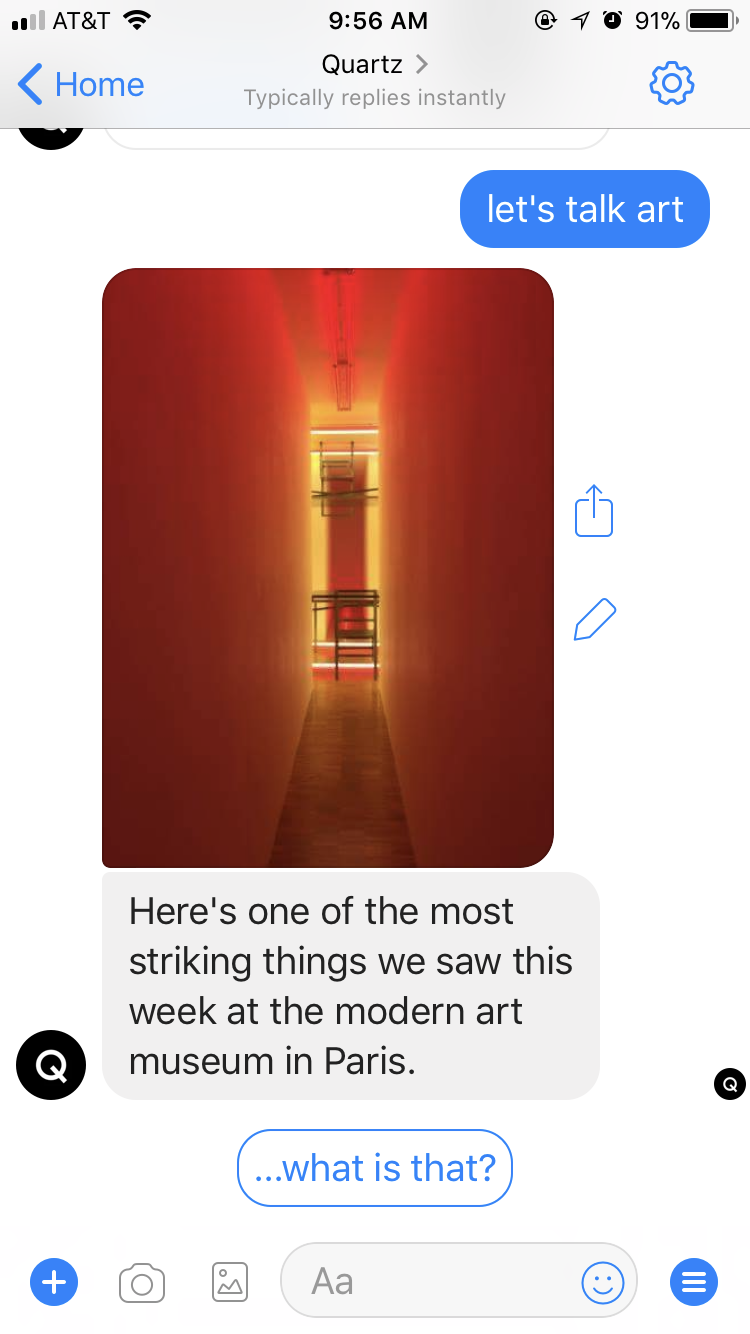 (Quartz emphasizes that this is not a replica of its main, chat-focused news app, which has been fiddling with augmented reality capabilities and which Quartz claims has been seen “over one million downloads.”)
(Quartz emphasizes that this is not a replica of its main, chat-focused news app, which has been fiddling with augmented reality capabilities and which Quartz claims has been seen “over one million downloads.”)
 After tapping through a series of funny introductory chat options, the bot begins to offer a lot of options to explore, from art exhibits to news (at least for me this morning, the news experience on Messenger and on the news app are exactly the same, with the same buttons to tap, the same gifs and emojis, and the same articles on the healthcare industry “bracing for Amazon’s impact” and the gender gap). I then tried to go back to the content options the bot offered me when I first launched it, and got into a brief loop of the bot not understanding my demands, before finally getting into a series of messages on productivity and a framework for improving that.
After tapping through a series of funny introductory chat options, the bot begins to offer a lot of options to explore, from art exhibits to news (at least for me this morning, the news experience on Messenger and on the news app are exactly the same, with the same buttons to tap, the same gifs and emojis, and the same articles on the healthcare industry “bracing for Amazon’s impact” and the gender gap). I then tried to go back to the content options the bot offered me when I first launched it, and got into a brief loop of the bot not understanding my demands, before finally getting into a series of messages on productivity and a framework for improving that.
Just so you know where I’m coming from: I personally have trouble using chat bots the way the majority of them currently function, though many news organizations from local to national to global have deployed them relatively successfully, in focused ways. I find the attempted verisimilitude off-putting. I can see where they’re useful, but there’s never enough flexibility in possible user journeys for me. I haven’t tried wading into Facebook Messenger’s Discover section for months.
Quartz says its good run with its Quartzy bot — 90 percent of users completing the experience, with 0 percent unsubscribing — fed into the development of its newest Messenger bot. It’s also applied what it’s learned about writing for compelling chat experiences through its main news messaging app, and the many projects it’s launched through its Bot Studio:
We built Quartz for Messenger because we believe messaging is an important and enduring new habit for the audience we aspire to reach, just like email and the web. Our award-winning app taught us that many people love getting our journalism in a conversational format, and over the past two years we’ve learned a lot about writing for that kind of interface.
That’s why we started the Quartz Bot Studio, which builds experiences for messaging and voice platforms. Over the past year, we’ve tried a variety of approaches to bot-based journalism, from tests on Messenger to tools for Slack to skills for Amazon Alexa. We applied the lessons from those experiments to this new product, our biggest yet.
This, as my colleague Ricardo Bilton pointed out to me, is an important point: We (okay, let’s just say I) may not like the bot experiences available to us now. But this experimentation will feed into better smart speaker experiences, more advanced chatbot experiences, and more smart experimentation.